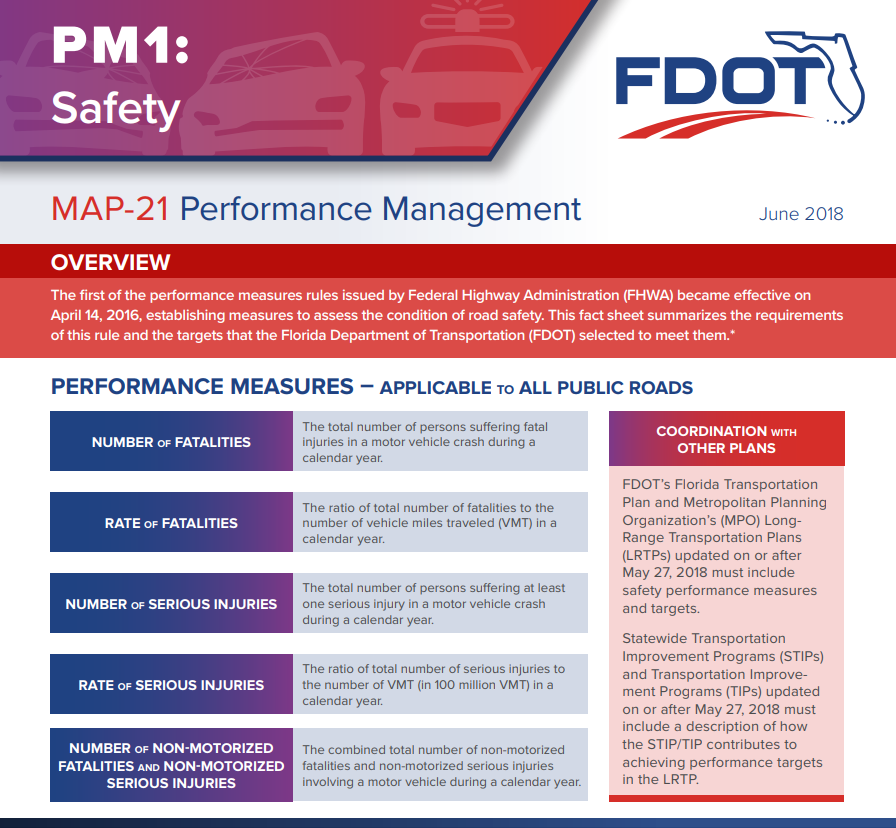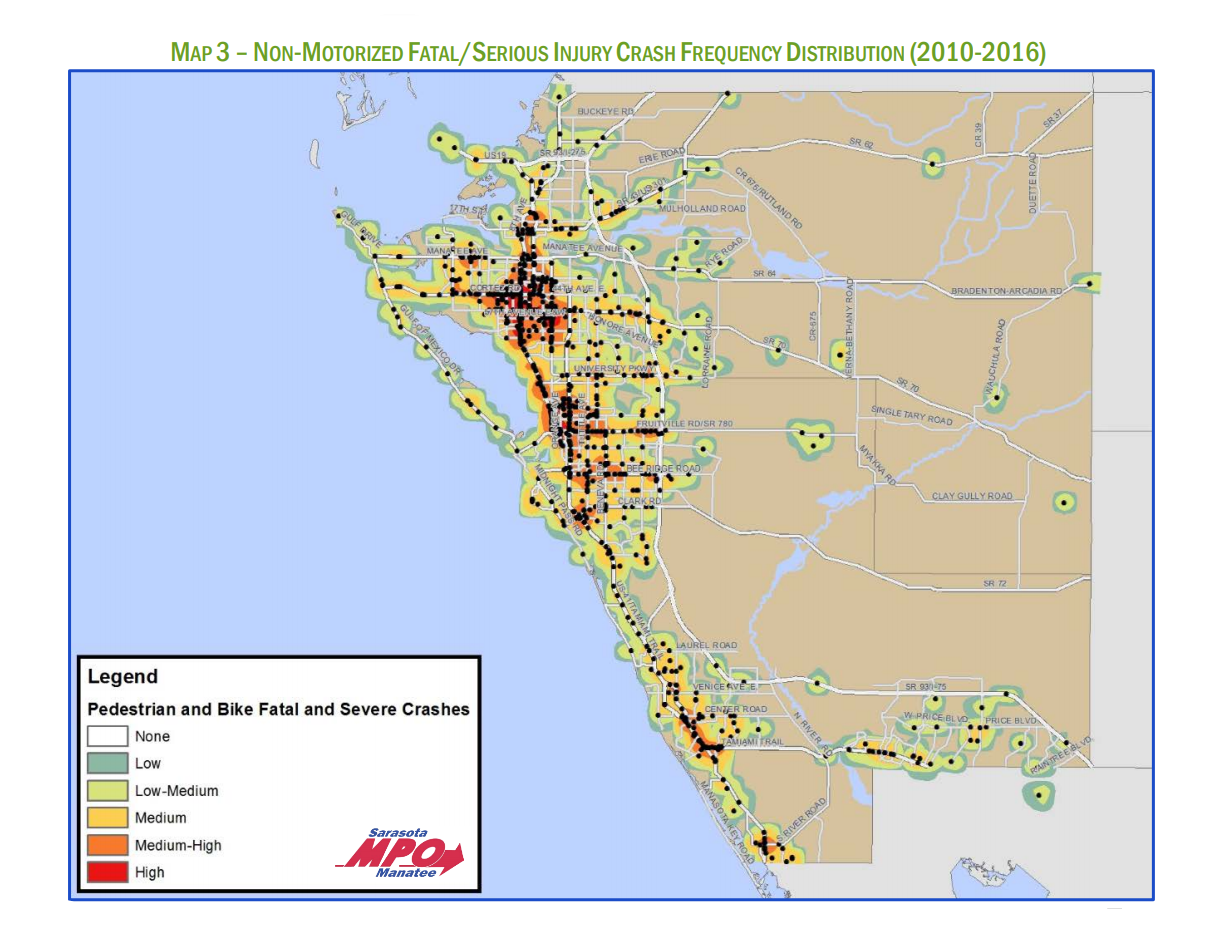
Share On Social!
One traffic death is too many.
That’s why Florida (25.6% Latino) has become the first U.S. state to adopt a goal of zero traffic and pedestrian deaths each year.
The Florida Department of Transportation (FDOT) even established safety performance targets to align with its “Driving Down Fatalities” vision for a fatality-free transportation system.
Read how they did it below in Part 3 of Salud America!’s three-part series on transportation changes in Florida. Part 1 examined Florida’s reinvention of Complete Streets. Part 2 examined the potential for public transit integration.
New Traffic Safety Targets
State departments of transportation (DOTs) and Metropolitan Planning Organizations (MPOs) get money for transportation projects from multiple sources. Each source has its own rules, standards, and requirements for performance management.
The Federal Highway Administration’s Highway Safety Improvement Program gives money to state DOTs for activities to reduce fatalities and serious injuries on all public roads.
 States must first meet 2016 safety performance measure rules. The rules ensure State DOTs choose efficient investments for federal transportation funds, and can be evaluated on their progress.
States must first meet 2016 safety performance measure rules. The rules ensure State DOTs choose efficient investments for federal transportation funds, and can be evaluated on their progress.
“The rule will increase focus on investments that will help to reduce fatalities and serious injuries,” according to the performance measure rules.
For the highway dollars, state DOTs must meet five safety targets:
- number of fatalities
- rate of fatalities per vehicle miles traveled (VMT)
- number of serious injuries
- rate of serious injuries per VMT,
- number of combined non-motorized fatalities and non-motorized serious injuries
State DOTs had to set statewide targets by August 2017.
To determine the target for number of fatalities, for example, add the number of fatalities for the most recent five consecutive calendar years, divide by five and round to the nearest tenth decimal place.
Many states did this five-year rolling average calculation to set a target.
Some states set more strict targets.
The Texas Department of Transportation (TxDOT), for example, established traffic fatality targets that would result in a 2% reduction below the original trend line projection in 2022. Instead of a target of 4,327 fatalities in 2022, Texas established a target of 4,241 fatalities.
FDOT, however, established even more strict targets.
Zero.
“One life lost is too many,” wrote Jim Boxold, FDOT Secretary, in the Florida Strategic Highway Safety Plan.
MPOs Setting Safety Targets
In addition to State DOTs, MPOs are required to set safety targets. MPOs may choose between supporting the statewide targets or adopting their own.
Unlike many states where the State DOT manages Highway Safety Improvement Program funds, Florida allocates Highway Safety Improvement Program funds to the MPOs.
Thus, MPOs in Florida have input on how safety funds are programmed. Additionally, MPOs can use other sources of funding to achieve safety targets.
Florida MPOs must establish safety targets by February 2018.
Annual reporting is required from State DOTs and MPOs.
Although the Federal Highway Administration does not directly assess MPO progress, it will evaluate progress through the periodic transportation planning reviews, including the MPO certification reviews and reviews of adopted/amended Long-Range Transportation Plans (LRTPs) and Transportation Improvement Programs (TIPs).
LRTPs are updated every five years and TIPs are updated each year to reflect the MPOs’ current priorities.
When developing, MPOs are required to include the goals, objectives, performance measures and safety in their LRTPs and are encouraged to identify contextual solutions for appropriate transportation corridors within their area to improve the transportation network for all users.
The Federal Highway Administration provides a guide for MPOs, Transportation Safety Planning and the Zero Deaths Vision: A Guide for Metropolitan Planning Organizations and Local Communities.
In the guide are examples of MPOs and communities using public health tools to advance their safety planning efforts.
The guide recommends using hot spot analysis to identify high-crash locations where safety investments are needed most.
Sarasota/Manatee MPO is doing just that to reach their safety targets, although they did not adopt all statewide FDOT’s safety targets.
The MPO mapped and analyzed the fatal and serious injury crashes in their two-county planning area from 2010 to 2016 and found particular roadway segments where crashes were a recurring concern.
Twenty corridors were identified as high priority locations for targeted strategies, like access management, sidewalk connections, street lighting, and six locations were selected for road safety audit field reviews, according to their 2018 Safety Assessment Report.
Projects to address safety on these corridors would, ideally, be included when the MPO updates their LRTP.
The Hillsborough MPO also didn’t establish all FDOT’s safety targets, but they identified severe crash corridors.
Hillsborough MPO understands that crashes are the result of unforgiving roadway designs combined with poor behavior and they approved $14.4 million in Highway Safety Improvement Program funds to reach their safety targets.
Some MPOs, like Broward MPO and Miami-Dade TPO, did adopt FDOT’s target of zero traffic fatalities and serious injuries and are working projects into their LRTPs.
If an MPO does not meet or achieve its established targets, the MPO is encouraged to develop a statement that describes how the MPO will work with the State and other partners to meet targets during the next performance period.
If the Federal Highway Administration determines that FDOT has not met or made significant progress toward meeting safety performance targets, FDOT must:
- use a portion of its obligation authority only for Highway Safety Improvement Program projects; and
- submit an annual implementation plan that describes actions FDOT will take to meet their targets, according to an FDOT Fact Sheet.
“FDOT and its traffic safety partners are committed to eliminating fatalities and reducing serious injuries with the understanding that the death of any person is unacceptable and based on that, zero deaths is our safety performance target,” according to the federal State Safety Performance Dashboard and Reports.
Aside from its effort on the Highway Safety Improvement Program, FDOT adopted a zero target for an additional six safety performance measures for a total of 11 in their 2018 Highway Safety Plan.
This is a drastic difference from the 2017 Highway Safety Plan where safety targets were not nearly as strict.
If you are concerned about safe, multimodal options, you can encourage your State DOT, MPO and city to establish more strict safety performance targets.
Learn more about transportation changes in Florida in the rest of Salud America!’s three-part series on transportation changes in Florida.
Part 1 was released Nov. 28. Part 2 was released Nov. 30.
Explore More:
Transportation & MobilityBy The Numbers
27
percent
of Latinos rely on public transit (compared to 14% of whites).



